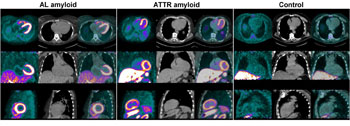Researchers Use PET to Visualize Cardiac Amyloidosis
By Andrew Deutsch
Posted on 22 Nov 2016
Results of a study have shown that a new non-invasive technique using PET imaging and a radiotracer, can visualize abnormal protein deposits in the heart, in a condition called cardiac amyloidosis.Posted on 22 Nov 2016
The researchers used fluorine-18 (F-18)-florbetaben, a radioactive tracer, and Positron Emission Tomography (PET) to visualize and quantify the deposition of amyloid proteins in heart muscle. The technique could be used to diagnose cardiac amyloidosis accurately and non-invasively, and could also help clinicians the monitor disease burden.

Image: Researchers have demonstrated that F-18-florbetaben PET imaging can be used to accurately differentiate between cardiac amyloidosis and hypertensive heart disease (Photo courtesy of W. Phillip Law/Princess Alexandra Hospital, Brisbane, Australia).
The study results were published in the November 2016 issue of The Journal of Nuclear Medicine. The researchers from the Princess Alexandra Hospital (Brisbane, Australia) performed F-18-florbetaben PET in 14 subjects and compared patients who had thickened heart muscle, secondary to amyloid deposition, with those that had thickened myocardium as a result of hypertensive heart disease.
The researchers found a higher target-to-background Standardized Uptake Values (SUV) ratio and percentage myocardial radiotracer retention in amyloid patients compared to the control subjects with heart disease. The results show that the new PET technique can be used to identify and differentiate between patients with cardiac amyloidosis and those with hypertensive heart disease.
Corresponding author of the study, Dr. W. Phillip Law, said, "The first signs and symptoms of the disease are non-specific and usually attributed to other conditions. Currently, there is no definitive test to diagnose cardiac amyloidosis other than an invasive biopsy of the heart muscle. Cardiac amyloidosis is often not diagnosed until late in the course of the disease, as the typical appearance of the infiltrated myocardium on echocardiography and MRI can be mistaken for other more prevalent disorders. Tailored molecular imaging with PET using florbetaben may significantly simplify the diagnostic algorithm for patients with suspected cardiac amyloidosis. Future studies investigating florbetaben uptake pattern in other [non-amyloid, non-hypertensive] causes of heart muscle thickening would further clarify the specificity of florbetaben. The relationship of PET quantification of florbetaben retention in the heart, with histological amyloid plaque burden, may provide another means of monitoring disease and could also be useful in monitoring response of cardiac amyloid to treatment, but further research needs to be undertaken to investigate this relationship."
Related Links:
Princess Alexandra Hospital














